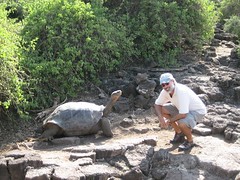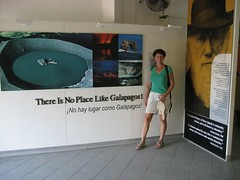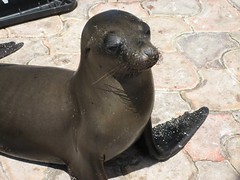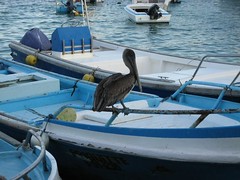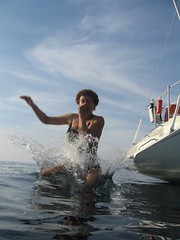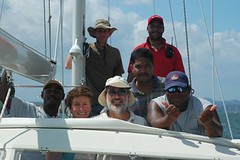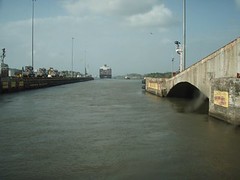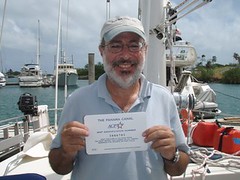We have been in the Galapagos for nearly a week now and are loving it. The only way to really get to see the whole range of wildlife here is to join one of the organized tours. There are dozens of them everyday, and it seems that for cruisers like us, the best option is to join one of the many day tours that run out of Puerto Ayora where we are anchored. We did tours the last two days – and had a great time.
Our first tour was to the Island of Floreana which is about 40 nm away from us. We got on board a small motor boat along with 12 other people, our guide, and the captain for a two hour high speed motor to the island. Most of us napped along the way and the seas were flat and calm so it was a pleasant ride. Once there we had a very hot hike over a lava path to a beautiful bay where we could snorkel. The path was very easy except for the last 50 yards where you had to grip onto a hot black lava rock cliff face and inch yourself over the edge of the cliff onto the beach. If you fell you would just go into the water, but still, it was a bit hair raising. On the beach was a huge male sea lion who came roaring over to anyone who came too near. In the water were dozens of small sea lion pups, all frolicking in the water, and diving around us as we came in for a swim. Mark saw an incredibly huge manta ray in the water – and caught a glimpse of a big sea turtle as well.
Then we went back to the boat and motored over to the next spot – an area called the Devils Crown ,”Corona del Diablo” – a fallen volcanic crater which has some incredible snorkeling. Just before we got in they gave us lunch – a huge pot of rice and chicken. I guess they don’t know the rule about waiting after you eat before you swim. When we got there the tour guide suddenly stripped down to his shorts and told everyone to hurry, hurry, hurry. We had to all get in the water at the same time because the current was so strong it would just pull us along the Crown and he wanted us to be together. We all leapt into the water from the boat. The guide failed to mention that it was like being in a tidal wave. It just picked you up and swept you along for at least 500 feet. Along the way were more beautiful fish than we have seen anywhere else – along with a few sharks! It was scary, but very fun. When we rounded the side of the crown we were out of the current and could enjoy the incredible fish there. Some sea lions were sliding off the cliffs into the water around us as well. Then once again the tour guide was suddenly shouting directions:”Ok, now everyone swim across this lagoon very very fast – the current is very strong here!” Not everyone heard him since some people were a little far away, so it was really up to each person to figure out what to do. Mark and I swam harder than we ever have in our lives. It was exhausting. After that swim we were once again in a calm spot and we were treated to seeing 4 or 5 white tipped sharks swimming in circles under us (they are supposed to be vegetarians). When we got back to the boat we were absolutely exhausted. Everyone was laughing because it was just not the type of tour that they would do in the U.S. without signing legal consent forms. I guess they haven’t lost too many people yet! That night we were in bed by 8:00 p.m. and slept for 10 hours.
The next day we did another tour, this one a lot more sedate. We started out with a bus ride across the island of Santa Cruz which took about an hour. Then we got into a nice motor boat for a nice calm 1 hour trip to the island of North Seymour. This is an incredible island just filled with frigate birds, blue footed boobies, and marine iguanas. As someone on our trip said, it felt like you were watching a national geographic movie, but you were in it. The male frigate birds have these huge red heart-shaped sacks under their necks and when they want to attract the females they puff them out so they look like a huge red balloon heart just under their beaks. It is so beautiful. The blue footed boobies are incredible and we saw some of them doing their mating dance, an elaborate ritual which includes them picking up and putting down little pieces of straw in front of each other, and the males singing out and ruffling all their feathers out in a big show. The males and females have different sounds and the whole island is filled with the sounds of all the birds putting on their shows. Since it is mating season now for both of these birds we were able to see dozens of them strutting their stuff, incubating eggs, and we even saw a few baby frigates. The marine iguanas are a different story – silent and still – they sit on the rocks and in the bushes looking like prehistoric animals. After a couple of hours watching this incredible display we went back to the boat to motor over to our next stop on the tour. This time we had a very delicious fish lunch, prepared for us on the boat. Once again, as soon as lunch was over it was time to snorkel. The snorkeling was off of a beautiful white sand beach, Las Bachas, and was much less wild than the day before. The snorkeling was good, but the best show was over our heads. There were thousands of boobies and other birds on the rocks beside the beach, and they all decided to fly off the rocks together and dive for fish. Since the fish they were diving for were basically just a few yards away from us, it was quite a sight to see them all rise from the rocks and come flying over us in a huge mass- really beautiful – but also very funny as you know what birds tend to do when they fly overhead! Luckily we could just dive under the water to wash off.
Today we are just hanging out on the boat – attending to boat business. We will spend the afternoon at the internet cafe in town posting our pictures to the blog ( if the internet is working that is – it has not been for the past couple of days) and then have dinner with Craig (from “Patriot”), whom we met in Panama.
L.

